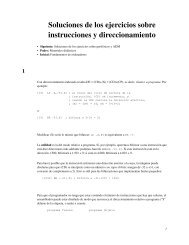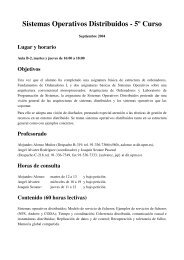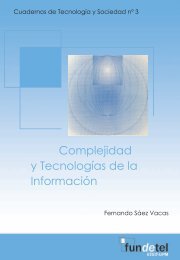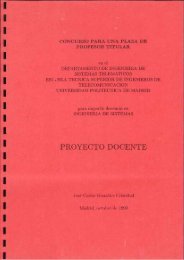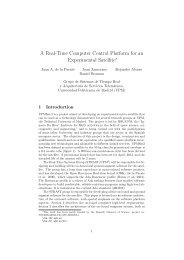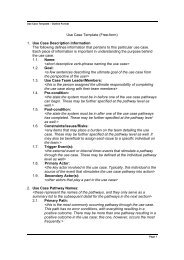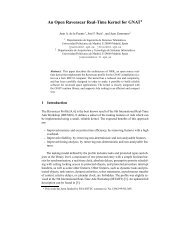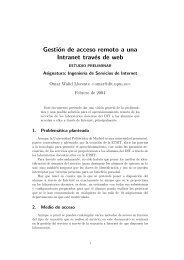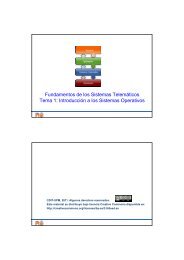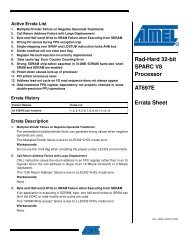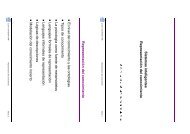Real-Time Programming with GNAT - DIT - Universidad Politécnica ...
Real-Time Programming with GNAT - DIT - Universidad Politécnica ...
Real-Time Programming with GNAT - DIT - Universidad Politécnica ...
Create successful ePaper yourself
Turn your PDF publications into a flip-book with our unique Google optimized e-Paper software.
One aspect where we have tried to enhance is timemanagement. The second test is focused on showing ameasurement of this improvement. This test has not beenapplied to the <strong>GNAT</strong> port that uses Pthreads over DOSbecause it does not run well <strong>with</strong> priorities. In fact, theDOS implementation has not a true pre-emptive priorityscheduling. Figure 3 displays the results of this test, whichshow that there is an improvement of about 20% in theamount of CPU time which is needed for the execution ofdelay statements.Efficiency is certainly an issue, but in real-timeapplications predictability is the main problem. Figure 3has not enough resolution to show this aspect, but from theexperiments that we have carried out we have measured adifference between the best and the worst trial which isabout 350 times bigger on the Linux implementation thanon JTK.5. ConclusionWe have shown that it is possible to significantly improvethe predictability and efficiency of tasking in <strong>GNAT</strong> bydesigning a simple multitasking kernel which is directlytailored to support the Ada 95 functionality. By eliminatingdependence on Pthreads, we have achieved a bare machineimplementation <strong>with</strong> a predictable execution timing. Wealso have eliminated the very unpredictable delays due tooperating system processes. In summary, we believe thattrue real-time programming in Ada 95 is a real possibility<strong>with</strong> our approach.Of course, since the POSIX interface and semantics arenot used, there is a loss in portability and generality. Webelieve that is the price that has to be paid for improveddeterminism and efficiency, which is the primary goal ofreal-time systems.The JTK library is available from:References[1] T.P. Baker and E.W. Giering, GNU Low-Level InterfaceDefinition. Technical Report, Florida State University, June1993. Available by anonymous ftp from ftp.cs.fsu.edu.[2] T.P. Baker, Frank Mueller and Viresh Rustagi, Experience<strong>with</strong> a Prototype of the POSIX Minimal <strong>Real</strong>time SystemProfile, Proceedings of the 11th IEEE Workshop on <strong>Real</strong>-<strong>Time</strong>Operating Systems and Software, May 1994.[3] T.P. Baker, Dong-Ik Oh and Seung-Jin Moon, Low-Level AdaTasking Support for <strong>GNAT</strong> Performance and PortabilityImprovements, Wadas’96 Proceedings, 1996.[4] E.W. Giering and T.P. Baker, POSIX/Ada <strong>Real</strong>time Bindings:Description of Work in Progress, In Proceedings of the NinthAnnual Washington Ada Symposium, ACM, July 1992.[5] Dong-Ik Oh and T.P. Baker, Gnu Ada’95 TaskingImplementation: <strong>Real</strong>-<strong>Time</strong> Features and Optimization, InProceedings of the 1997 Workshop of Languages, Compilersand Tools for <strong>Real</strong>-<strong>Time</strong> Systems (LCT-RTS), Las Vegas,Nevada, 1997.[6] Dong-Ik Oh and T.P. Baker, Optimization of Ada’95 TaskingConstructs, Triada’97, St. Louis, Missouri, 1997.[7] Dong-Ik Oh, T.P. Baker and Seung-Jin Moon, The GNARLImplementation of POSIX/Ada Signal Services, In Ada-Europe’96 Proceedings, pages 276-286.[8] On-Line Applications Research Corporation, RTEMSApplications C User’s Guide, Sep 1997, http://www.gnatrtems.com.[9] José F. Ruiz and Jesús M. González-Barahona, Implementinga New Low-Level Tasking Support for the <strong>GNAT</strong> RuntimeSystem, In Ada-Europe’99 Proceedings, Santander, Spain,June 1999.[10]V. Yodaiken, The RT-Linux Approach to Hard <strong>Real</strong>-<strong>Time</strong>.Available at http://rtlinux.cs.nmt.edu/~rtlinuxwhitepaper/short.html.ftp://ftp.dit.upm.es/str/software/jtk/and is covered by a modified GPL license. Moreinformation about the JTK library can be consulted at:http://www.dit.upm.es/~jfruiz/jtk.htmlAcknowledgmentsThis work has been partially supported by CICYT underproject TIC96-0614.



